Cone crushers and impact crushers are two common types of crushing equipment used in mining, construction, and other industries. Both have their unique advantages, and the choice between the two depends on various factors such as the type of material to be crushed, the desired product size, and the production capacity. I will highlight the advantages of cone crushers over impact crushers.
Particle Shape:
One of the significant advantages of cone crushers over impact crushers is their ability to produce a more cubical product with a narrower particle size distribution. Cone crushers use compression crushing, which results in a more consistent product shape. On the other hand, impact crushers use impact forces to break down particles, often producing flatter and more elongated products. The cubical shape is desirable for concrete and asphalt production, as well as for certain high-quality aggregate applications, as it provides better workability and strength properties.

Reduction Ratio:
Cone crushers typically have higher reduction ratios compared to impact crushers. Reduction ratio refers to the ratio of the top size of the input material to the final product size. A higher reduction ratio means that more significant reduction of the material can be achieved. Cone crushers are well-suited for secondary and tertiary crushing stages, where the aim is to obtain a finer product size. Impact crushers are generally used for primary crushing and are best suited for materials with lower reduction requirements.
Energy Efficiency:
Cone crushers are generally more energy-efficient than impact crushers. The energy consumption of cone crushers is relatively low compared to impact crushers, especially in the low-to-medium capacity range. Cone crushers utilize the principle of inter-particle crushing, which reduces the energy required to break rocks, as opposed to the impact crushing used in impact crushers. This energy efficiency can lead to cost savings in terms of fuel consumption and overall operational costs.
Wear Parts and Maintenance:
Cone crushers generally have a longer lifespan for their wear parts compared to impact crushers. The wear parts in a cone crusher are made of high-strength manganese steel or other materials, designed to withstand high wear and abrasion. Additionally, the design of cone crushers allows for easy replacement of worn-out components, reducing downtime and maintenance costs. In contrast, impact crushers have a higher wear rate for their blow bars and impact plates, necessitating more frequent replacement, leading to increased maintenance expenses.
Versatility:
Cone crushers offer greater versatility in terms of the range of materials they can handle. They are suitable for various types of rocks and minerals, ranging from soft to hard and from abrasive to non-abrasive. Cone crushers can be adjusted to different crushing chambers to optimize the crushing process according to the material characteristics and required product size. Impact crushers are better suited for processing softer and less abrasive materials, such as limestone and some metallic ores.
Noise and Dust Suppression:
Cone crushers tend to produce less noise and dust pollution compared to impact crushers. As cone crushers crush the material by compression and do not throw the material against hard surfaces like impact crushers, they generate less noise during operation. Additionally, cone crushers can be equipped with effective dust suppression systems, reducing airborne dust and improving the working environment.
Safety:
Cone crushers offer enhanced safety features, such as hydraulic systems that provide overload protection and allow for tramp iron release in case of an uncrushable object entering the crushing chamber. These safety features help to protect the crusher and its operators from potential damage and accidents. Impact crushers also incorporate safety measures, but the design and implementation might vary between different models.
Cone crushers offer several advantages over impact crushers, including superior particle shape, higher reduction ratios, better energy efficiency, longer wear part lifespan, greater versatility, and improved safety and environmental aspects. However, the choice between the two crushers depends on the specific requirements of the application, and factors such as material characteristics, desired product size, and production capacity should be carefully considered before making a decision.
